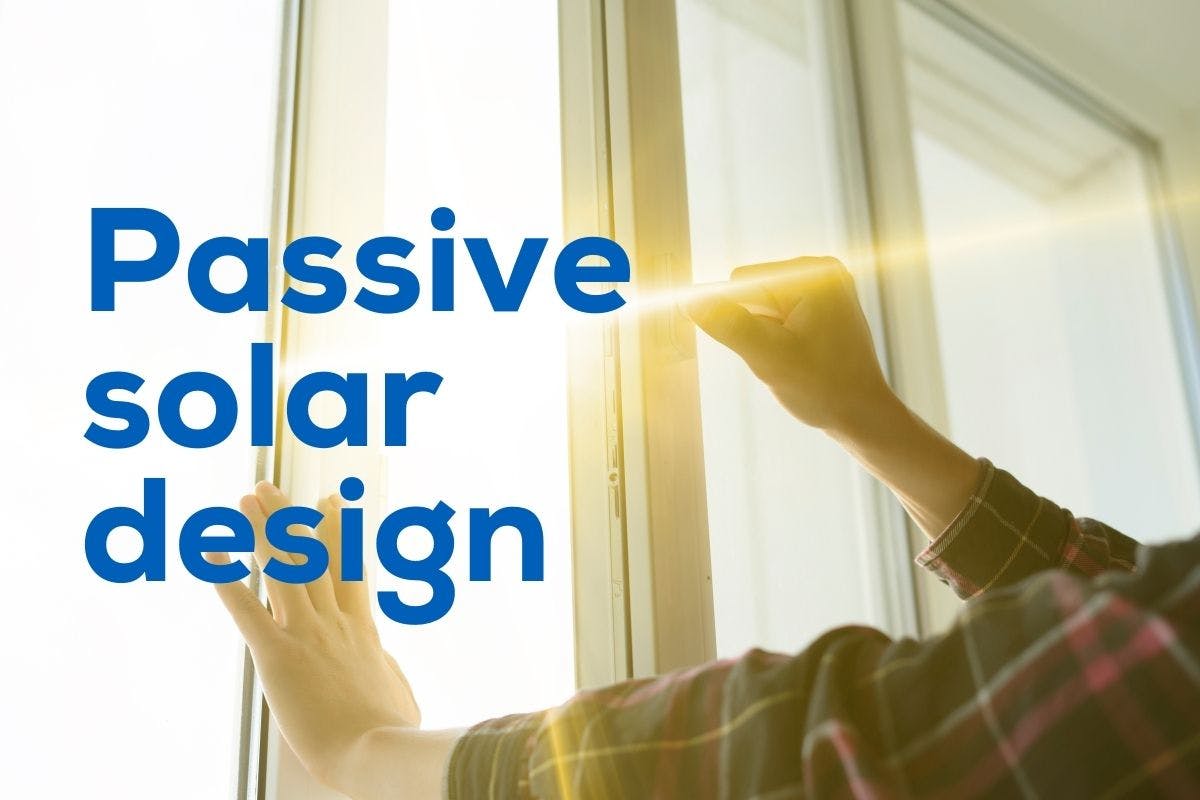To build a more sustainable future, Palmetto believes in harnessing the sun's power in every way possible – from renewable electricity systems to passive solar design.
Although our solar experts primarily focus on helping homeowners save money with solar panels, passive solar design is an important subject that every eco-conscious person should consider to reduce energy usage and related expenses at home.
Below, we will walk through the essential elements, techniques, and concepts of passive solar design so that you can use more of the sun’s energy to power a sustainable, low-cost lifestyle.
What is passive solar design?
The Williams College Zilkha Center for Environmental Initiatives defines passive solar design as “the use of the sun’s energy for the heating and cooling of living spaces by exposure to the sun.”
In other words, if you have ever opened up the blinds to let more of the sun’s heat inside, then you already understand the basic concept of passive solar design.
Active vs Passive Solar Systems
Now before we get too deep into the details of what passive solar design really is, let’s first look at what passive solar design is not.
Passive solar design and passive solar systems are separate from active solar energy systems, such as the solar panels for your home that produce electricity.
To clear up this distinction, the Environmental and Energy Study Institute (EESI) explains that passive solar systems are “structures whose design, placement, or materials optimize the use of heat or light directly from the sun,” while active solar systems convert the sun's energy into “a new form, such as hot water or electricity.”
Passive Solar Homes Elements
If you look at the history of solar energy, people have been using passive solar techniques for millennia, which means at this point collectively, we have it down to a science. Passive solar homes are often intentionally built and incorporate most or all of the specific elements outlined in the table below.
| Element | Description |
|---|---|
| The Aperture | An aperture, meaning a hole or gap, is a large glass area on a solar home that faces south (in the US) to let sunlight seep in most of the day. Passive solar homes may have one large window wall or several intentionally positioned apertures. |
| Solar Control / Overhang | A solar control or solar shade is a small piece of overhanging roof above an aperture. This overhang is specifically designed to help maintain comfortable interior temperatures year-round by allowing sunlight in during the winter and blocking out high summer sun exposure. |
| Thermal Mass | A thermal mass is a collection of building materials that can be used to capture, store, and distribute heat from direct sunlight. Typical thermal masses include walls, floors, and other building features made of concrete, brick, stone, or tile. |
| Smart Building Design | Passive solar homes include several smart building design features to manage solar intake and maintain comfortable living conditions such as shutters, ventilation, and ceiling fans. |
| Energy Efficiency Elements | To reduce heat loss and additional energy consumption, passive solar homes are typically well-insulated. This includes a tight building envelope maintained with sufficient air sealing along windows, doors, and throughout the home. |
Solar Panels and Passive Solar Design
If you love solar energy as much as we do (and even if you don’t), it is very easy to incorporate electricity-generating solar panels into a home designed for passive solar heating and cooling.
In many instances, an overhang or solar control can be situated at the best angle and orientation for solar energy generation, allowing passive solar homeowners to install panels, have their cake, and eat it too!
In the event that there is not enough south-facing roof space to host solar panels, creative passive solar home designers may also be able to raise ground-mounted solar panels as a carport or an additional shaded outdoor area.
Auxiliary Heating and Cooling Systems in Passive Homes
Passive solar design is a great way to reduce energy consumption at home. With that said, the majority of passive solar heating and cooling systems will fail to deliver comfortable living conditions 24/7/365 without the help of additional energy-consuming devices.
To kick in some extra heat in the winter, passive solar homes often get assistance from woodstoves, heat pumps, space heaters, or other appliances. Likewise, passive solar homeowners living in warmer climates may want to consider AC heat pumps, swamp coolers, or the best fans that money can buy to keep things cool indoors all summer long.
Retrofitting passive solar home techniques
If you are not building a brand new passive solar home, there are still many ways to incorporate passive solar design into your existing living space. For instance, if an energy efficiency audit shows that you are losing a lot of heat through your roof, it may be possible to add insulation to your attic or several ceiling fans to help keep any daily solar warmth inside your home.
Alternatively, if you have room on your property (and in your budget) for an additional living area, you can add a “sunspace” to quickly reap the benefits of passive solar design. Also known as a sunroom, solar room, or solarium (but not to be confused with a greenhouse), a sunspace is an opportunity to build a one-room passive solar home that can also be used to help heat adjacent living spaces.
Review and Additional Resources
In summary, passive solar design enables you to use the sun’s power for your home’s heating and cooling with minimal additional energy consumption required. If you are building a new passive solar home or simply want to learn more, we recommend reading all of the Passive Solar Technology Basics from the National Renewable Energy Laboratory (NREL).
For questions about solar electricity, sustainably at home, or anything else under the sun, please feel free to contact Palmetto today!

